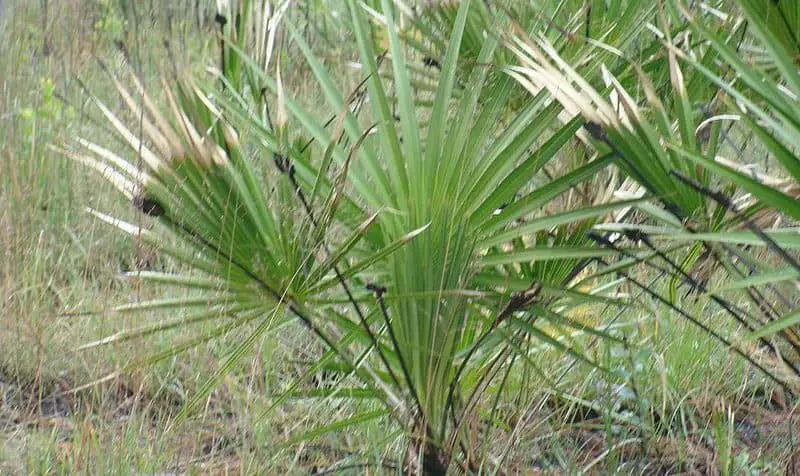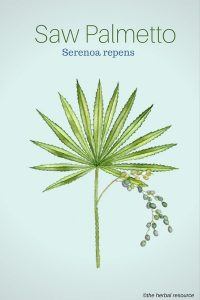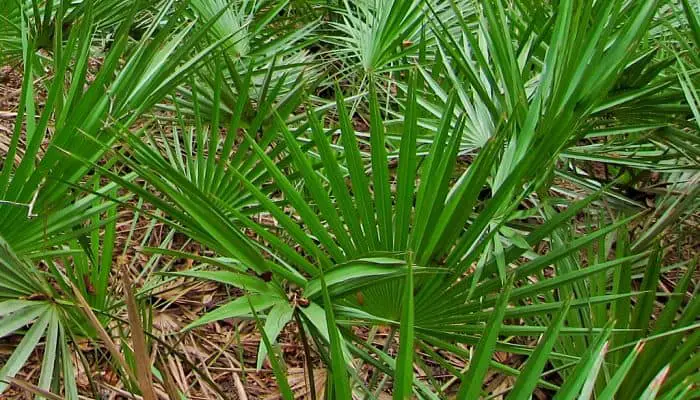Botanical Name of Saw Palmetto: Serenoa repens.
Other Common Names: Sabal, Sabal Fructus, Fructus Serenoae, Sägepalmenfrüchte, Sägepalme.
Habitat: Saw palmetto is found in sandy coastal lands or as undergrowth in pine forests in the Southeastern United States.
Description: Saw palmetto is a fan palm plant. The flowers produced by this plant are yellowish-white and the fruit is a reddish-black fleshy fruit with a pit.
Plant Parts Used: The fruit.
The Native Americans ate the fruit for nourishment but also used it for a treatment of many urinary and genital disorders. The European settlers saw this use and developed additional applications for it.
An extract from the fruit is used in herbal medicine today.
Essential fatty acids and phytosterols are found in this extract.
The fatty acids contained in saw palmetto are lauric acid, palmitic acid, oleic acid, and myristic acid. The polysaccharides; galactose, arabinose, and uronic acid, are also found in the fruit.

Therapeutic Uses, Benefits and Claims of Saw Palmetto
Historically, saw palmetto has been used as a tea to treat benign enlargement of the prostate.
It was commonly used to treat frequent urinary tract infections and it was also believed it could increase sex drive in men and sperm production.
Frequent urination and excessive night urination, due to inflammation of the bladder or prostate, was a common condition treated by saw palmetto in the past.
Today many studies have been, and still are being, conducted on saw palmetto extracts to test some of the common claims.
It is commonly used today to tone the male reproductive system and boost the production of reproductive hormones in men.
It has also been used by females with fertility issues and reproductive organ problems as well. It is still being used to treat many urinary tract disorders.
In some cases it has been shown to aid thyroid function and as a herbal remedy for asthma, bronchitis and other bronchial and throat problems, especially those related to excess mucous secretions.
One of the other issues that its use has been focused on is benign prostatic hyperplasia (BPH.)
Testosterone collects in the prostate and the converts to dihydrotestosterone (DHT.) This causes the cells to multiply quickly causing an enlargement of the prostate. Saw palmetto is thought to inhibit the conversion of testosterone to DHT and also the binding of DHT to receptor sites.
Saw palmetto has also been touted as an anabolic agent, contributing to muscle growth. This is also a by-product of the action of testosterone, stopping its conversion to DHT. This leads to more free-floating testosterone, which is an anabolic agent and leads to more muscle mass.
There are few, positive clinical trials published on the benefits of saw palmetto extracts both topically and internally as an herbal remedy for hair loss (baldness) in men.
Potential Side Effects of Saw Palmetto
This herb has been found to be relatively safe.
There have not been any contraindications or drug interactions found. The long-term effects have not been analyzed yet but it appears safe at normal doses.
It is also safe to mix with other herbs. It may be taken with damiana and gotu kola for reproductive system health. Horsetail and hydrangea can be taken with it to help slow or reverse growth in enlarged prostate glands.
Even though it has been shown to be safe in normal doses it is important not to use larger than normal doses.
It is also important to consult a physician for those how are on prescription medications or may be pregnant.
One of the primary active ingredients in saw palmetto, beta-sistosterol, is similar to cholesterol on a chemical level. In very rare cases, mild nausea, reduced libido, and erectile dysfunction may be experienced.
As with any herbal supplement, if any side effects are experienced during use, discontinue the supplement and if they do not clear up consult a physician.
Thordur Sturluson
Latest posts by Thordur Sturluson (see all)
- What is the Difference Between Hemp and Marijuana? - June 3, 2019


I have used 1800 mg in divided doses for 40 years.saw Palmerston used to say berries now bottle says whole herb. I now wonder if they are cutting corners to make money.